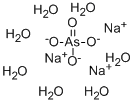SODIUM ARSENATE, HEPTAHYDRATE
Synonym(s):Disodium hydrogen arsenate heptahydrate;di-Sodium hydrogen arsenate heptahydrate
- CAS NO.:10048-95-0
- Empirical Formula: AsH15Na2O11
- Molecular Weight: 312.01
- MDL number: MFCD00149179
- EINECS: 677-900-0
- SAFETY DATA SHEET (SDS)
- Update Date: 2024-12-18 14:08:52

What is SODIUM ARSENATE, HEPTAHYDRATE?
Chemical properties
white or colourless crystals
Chemical properties
Sodium arsenate heptahydrate is a poisonous solid/powdered solid/crystalline powder. It is odorless with a saline taste. The aqueous solution is alkaline to litmus and decomposes on heating at 100°C (212°F), rapidly becoming anhydrous. It is incompatible with acids, iron, aluminum, and zinc in the presence of water, and strong reducing agents. It is non-corrosive in the presence of glass. Sodium arsenate heptahydrate emits toxic fumes of arsenic when heated to decomposition.
The Uses of SODIUM ARSENATE, HEPTAHYDRATE
It is used as a source of soluble arsenic.
The Uses of SODIUM ARSENATE, HEPTAHYDRATE
Sodium hydrogen arsenate heptahydrate is used as a source of soluble arsenic and in dyeing and printing with Turkey-red oil. It also acts as a veterinary drug for anti-parasitic, skin diseases, blood diseases, rheumatism and asthma.
Definition
ChEBI: A hydrate that is the heptahydrate form of disodium hydrogen arsenate.
General Description
Odorless white crystals. Becomes anhydrous at 212°F. Aqueous solution is alkaline to litmus.
Air & Water Reactions
Effloresces in warm air. Water soluble.
Reactivity Profile
SODIUM ARSENATE, HEPTAHYDRATE is incompatible with strong oxidizing agents and strong acids. Also incompatible with iron, aluminum and zinc in the presence of water. .
Health Hazard
Arsenic is highly toxic. Exposures through ingestion and inhalation cause adverse health
effects that include, but are not limited to, irritation with itching, burning, and conjunctiva
damage, photophobia, corneal injury, dimness of vision, diplopia, lacrimation, cold
and clammy skin, low blood pressure, weakness, headache, cramps, infl ammation of the
mucous membranes with cough and foamy sputum, restlessness, dyspnea, cyanosis, pulmonary
edema, burning in the esophagus, vomiting, and bloody diarrhea, damage to the
liver and kidneys, and death from circulatory failure.
Repeated exposures to sodium arsenate heptahydrate cause bronzing of the skin, edema,
dermatitis, and lesions. Repeated or prolonged inhalation of dust may cause damage to the nasal septum. Chronic exposure from inhalation or ingestion may cause hair and weight
loss, a garlic odor to the breath and perspiration, excessive salivation and perspiration, central
nervous system damage, hepatitis, gastrointestinal disturbances, and cardiovascular
damage.
Fire Hazard
Literature sources indicate that SODIUM ARSENATE, HEPTAHYDRATE is nonflammable.
Safety Profile
Confirmed human carcinogen. Poison by subcutaneous route. An experimental teratogen. Other experimental reproductive effects. Human mutation data reported. See also ARSENIC COMPOUNDS. When heated to decomposition it emits toxic fumes of arsenic.
storage
Workers should keep containers of sodium arsenate heptahydrate tightly closed and under lock and key in a cool, well-ventilated room/store area.
Purification Methods
Crystallise it from water (2mL/g).
Precautions
Occupational workers should avoid ingestion or breathing the dust of sodium arsenate
heptahydrate. On exposure to sodium arsenate heptahydrate, immediately fl ush eyes with
plenty of water. Occupational workers should wear suitable protective clothing, suitable
respiratory equipment, and work in proper ventilation. During use, workers should avoid
contact with the skin, eyes be away from incompatibles such as acids. For any kind of accidental
ingestion, workers should seek immediate medical advice.
Occupational workers and users should be aware that sodium arsenate heptahydrate is
very toxic and its improper use and handling is dangerous, causing fatal injury if swallowed
and/or inhaled. Sodium arsenate heptahydrate is a cancer hazard. It contains inorganic
arsenic that can cause cancer. The risk of cancer from sodium arsenate heptahydrate
depends on the duration and level of exposure. Because sodium arsenate heptahydrate
causes irritation to the skin, the eyes, and the respiratory tract, and causes liver and kidney
damage, workers should handle the chemical substance only with adequate ventilation,
respiratory equipment, and under qualifi ed supervision.
Properties of SODIUM ARSENATE, HEPTAHYDRATE
| Melting point: | 180 °C (dec.)(lit.) |
| Density | 1,88 g/cm3 |
| solubility | H2O: slightly soluble(lit.) |
| form | Granular |
| color | White |
| Specific Gravity | 1.88 |
| Water Solubility | Soluble in water and glycerol. |
| Stability: | Stable. Incompatible with strong reducing agents, strong oxidizing agents, strong acids. Incompatible with iron, aluminium and zinc in the presence of water. |
| CAS DataBase Reference | 10048-95-0(CAS DataBase Reference) |
| EPA Substance Registry System | Disodium arsenate heptahydrate (10048-95-0) |
Safety information for SODIUM ARSENATE, HEPTAHYDRATE
| Signal word | Danger |
| Pictogram(s) |
 Skull and Crossbones Acute Toxicity GHS06  Health Hazard GHS08  Environment GHS09 |
| GHS Hazard Statements |
H350:Carcinogenicity H410:Hazardous to the aquatic environment, long-term hazard |
| Precautionary Statement Codes |
P201:Obtain special instructions before use. P202:Do not handle until all safety precautions have been read and understood. P261:Avoid breathing dust/fume/gas/mist/vapours/spray. P273:Avoid release to the environment. P301+P310:IF SWALLOWED: Immediately call a POISON CENTER or doctor/physician. |
Computed Descriptors for SODIUM ARSENATE, HEPTAHYDRATE
| InChIKey | KOLXPEJIBITWIQ-UHFFFAOYSA-L |
New Products
Tert-butyl bis(2-chloroethyl)carbamate (S)-3-Aminobutanenitrile hydrochloride N-Boc-D-alaninol N-BOC-D/L-ALANINOL N-octanoyl benzotriazole 4-Hydrazinobenzoic acid 3,4-Dibenzyloxybenzaldehyde Electrolytic Iron Powder 1,1’-CARBONYLDIIMIDAZOLE R-2-BENZYLOXY PROPIONIC ACID 4-HYDROXY BENZYL ALCOHOL 1,1’-CARBONYLDI (1,2-4 TRIAZOLE) S-2-CHLORO PROPIONIC ACID (2-Hydroxyphenyl)acetonitrile 4-Bromopyrazole 5-BROMO-2CYANO PYRIDINE 5,6-Dimethoxyindanone 5-broMo-2-chloro-N-cyclopentylpyriMidin-4-aMine 3-(2,4-Dimethoxybenzyl)dihydropyrimidine-2,4(1H,3H)-dione 6-Bromo-3-iodo-1-methyl-1H-indazole 4-Ethylbenzylamine N-(5-Amino-2-methylphenyl)acetamide 2-(BOC-Amino)4-picoline 1-(4-Methylphenylsulfonyl)-1H-1,2,3-benzotriazoleRelated products of tetrahydrofuran








You may like
-
 Sodium Arsenate Hydrate CAS 10048-95-0View Details
Sodium Arsenate Hydrate CAS 10048-95-0View Details
10048-95-0 -
 Sodium arsenate, GR 98%+ CAS 10048-95-0View Details
Sodium arsenate, GR 98%+ CAS 10048-95-0View Details
10048-95-0 -
 Sodium arsenate 98% AR/ACS CAS 10048-95-0View Details
Sodium arsenate 98% AR/ACS CAS 10048-95-0View Details
10048-95-0 -
 SODIUM ARSENATE HEPTAHYDRATE AR/ACS CAS 10048-95-0View Details
SODIUM ARSENATE HEPTAHYDRATE AR/ACS CAS 10048-95-0View Details
10048-95-0 -
 Sodium arsenate dibasic heptahydrate CAS 10048-95-0View Details
Sodium arsenate dibasic heptahydrate CAS 10048-95-0View Details
10048-95-0 -
 100-71-0 99%View Details
100-71-0 99%View Details
100-71-0 -
 13162-05-5 N-Vinylformamide 99%View Details
13162-05-5 N-Vinylformamide 99%View Details
13162-05-5 -
 1446013-08-6 98%View Details
1446013-08-6 98%View Details
1446013-08-6